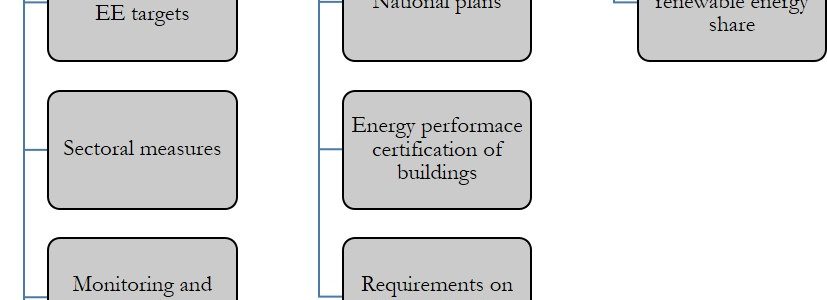
The European policies on nZEBs
The EPBD, as recast in 2010 (EPBD 2010/31/EU), together with the Energy Efficiency Directive (EED 2012/27/EU) and the Renewable Energy Directive (RED 2014/53/EU) represents the key regulatory framework adopted at EU level to promote an increase of energy efficiency and renewable energy production.
Energy Efficiency Directive (EED 2012/27/EU)
In October 2012, EU adopted the Energy Efficiency Directive 2012/27/EU. It established a set of measures for the promotion of energy efficiency, at all stages of the energy chain, starting from the production to final consumption. The aim is to achieve the target of 20% of energy savings by 2020. In November 2016, the European Commission proposed an update to this Directive, including a new 30% target by 2030.
The Directive applies minimum requirements and objectives, which are complementary to the indications of the EPBD 2010/31/EU; the Member States are allowed to set more tightening ones. Key measures to enhance the energy efficiency promoted by the directive are the followings:
- Energy saving efficiency targets for the Member States.
- Exemplary role of public buildings – article 5 sets binding renovation targets for public buildings.
- Energy efficiency obligations – obligations related to the previous point are also imposed. For instance, every year starting from 2014, each MS shall refurbish 3% of the buildings owned or occupied by central government.
- Energy audits and management – article 8 states that MS shall promote cost-effective, independent and high-quality energy audits for all final customers. Also, non-small and medium-sized enterprises shall implement energy or an environmental management system.
- Metering and billing – good energy consumption management requires that the consumer can easily access to data through individual metering and billing information.
- Qualification, accreditation and certification schemes, energy services and energy performance contracting, split incentives, online platform.
Although the above-mentioned measures have a higher impact on existing buildings, the application can also improve the energy efficiency of new constructions. In particular, the improvement of monitoring and billing approach as well as a structured energy management of buildings can foster the proper operation of nZEBs and guarantee the energy performance targets.
Energy Performance of Building Directive (EPBD 2010/31/EU)
The first version of the Directive was approved in December 2002 and recast in May 2010. This Directive established targets for the Member States to be fulfilled by all the new public buildings from January 2019 and all residential ones from 2021. As mentioned before, this Directive introduced the concept of nZEB and the main indications for implementation. It also added the concept of cost-optimality. Key elements of the directive are:
- Boosting the Member States to draw up National Plans towards nZEB, establishing definitions, requirements, and policies to reach the nZEB target.
- Encouraging the integration of renewable energy sources.
- Cost-optimality – Article 2.14 defines the cost-optimal level as “the energy performance level which leads to the lowest cost during the estimated economic lifecycle”.
- Energy performance certificates, introduced in the EPBD 2002/31/EC, serve as an information tool for building owners, occupiers, and real estate actors.
- Establishing regular inspections of heating and cooling systems.
- Certification of buildings, which only qualified experts are accredited to carry out independently.
Renewable Energy Directive (RED 2014/53/EU)
The Directive 2014/53/EU established an overall policy for the promotion of the energy production from renewable sources. It requires the Member States to fulfill at least 20% of its total energy consumption with energy from renewables by 2020. Also, it requires that at least 10% of transport fuels come from renewable sources. The 20% target was updated in November 2016. The new target requires at least 27% of energy from renewable energy sources in the final energy consumption by 2030.
Figure 1 summarizes the main measures promoted by the three directives that affect the path towards nZEB in Europe.

Figure 1: Key elements of European Directives (EED, EPBD, and RED).

